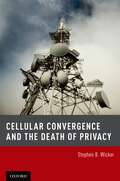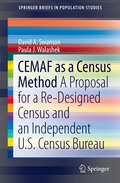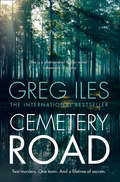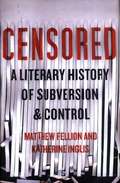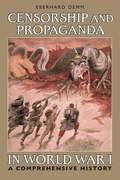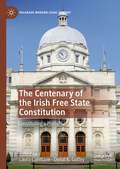- Table View
- List View
Cellular Convergence and the Death of Privacy
by Professor Stephen B. WickerCellular technology has always been a surveillance technology, but "cellular convergence" - the growing trend for all forms of communication to consolidate onto the cellular handset - has dramatically increased the impact of that surveillance. In Cellular Convergence and the Death of Privacy, Stephen Wicker explores this unprecedented threat to privacy from three distinct but overlapping perspectives: the technical, the legal, and the social. Professor Wicker first describes cellular technology and cellular surveillance using language accessible to non-specialists. He then examines current legislation and Supreme Court jurisprudence that form the framework for discussions about rights in the context of cellular surveillance. Lastly, he addresses the social impact of surveillance on individual users. The story he tells is one of a technology that is changing the face of politics and economics, but in ways that remain highly uncertain.
Cellular Convergence and the Death of Privacy
by Professor Stephen B. WickerCellular technology has always been a surveillance technology, but "cellular convergence" - the growing trend for all forms of communication to consolidate onto the cellular handset - has dramatically increased the impact of that surveillance. In Cellular Convergence and the Death of Privacy, Stephen Wicker explores this unprecedented threat to privacy from three distinct but overlapping perspectives: the technical, the legal, and the social. Professor Wicker first describes cellular technology and cellular surveillance using language accessible to non-specialists. He then examines current legislation and Supreme Court jurisprudence that form the framework for discussions about rights in the context of cellular surveillance. Lastly, he addresses the social impact of surveillance on individual users. The story he tells is one of a technology that is changing the face of politics and economics, but in ways that remain highly uncertain.
CEMAF as a Census Method: A Proposal for a Re-Designed Census and An Independent U.S. Census Bureau (SpringerBriefs in Population Studies)
by David A. Swanson Paula J. WalashekIn provocative terms that push the envelope of technical, administrative, and legal capabilities, Swanson and Walashek propose a re-vamped US census based neither on the current system, self-enumeration, nor its predecessor, door-to-door canvassing. Instead, they propose that it be built on a combination of four elements: (1) administrative records; (2) the continuously updated Master Address File; (3) survey data; and (4) modeling and imputation techniques. They use “Census-Enhanced Master Address File (CEMAF) as a descriptive term for their proposal, which is based on four principles and includes a proposal for an independent Census Bureau. They argue that evidence suggests that the methods used to conduct traditional census counts may be at the end of their useful working lives, as evidenced by increasing costs and declining response rates. Some of their ideas will seem farfetched. However, Swanson and Walashek believe this is the time to discuss radical proposals as governments re-examine the utility of traditional census counts and consider reductions, as is the case in Canada and England. This SpringerBriefs should be on the reading list of staff in statistical agencies grappling with rising costs and declining response rates, as well as census stakeholders concerned about costs, accuracy, and census utility.
Cemetery Road: A Novel
by Greg IlesTwo murders. One Town. And a lifetime of secrets. ‘Pure reading pleasure’ Stephen King The No.1 New York Times bestselling author of the Natchez Burning trilogy returns with an electrifying standalone. A tale of friendship, betrayal, and shattering secrets that threaten to destroy a small Mississippi town.
Censored: A Literary History Of Subversion And Control
by Inglis FellionThe list of books suppressed in the English language features the sacred and profane, poetic and pornographic, famous and infamous. A history of literary censorship is therefore a history not only of texts but of the authorities that have attempted to prevent their circulation: sovereigns, politicians, judges, prison officers, slaveholders, school governors, librarians, teachers, parents, students, editors and publishers. Censored deals with some of the most contentious and fascinating cases, including works now praised as literary masterpieces, such as James Joyce's Ulysses and Vladimir Nabokov's Lolita; as well as a troubling book about assassination that was implicated in a murder case. The books in this comprehensive study have been chosen to showcase the variety of suppressed literature, the methods and consequences of censorship, and landmarks in the history of free speech.
Censored: Distraction and Diversion Inside China`s Great Firewall
by Margaret E. RobertsA groundbreaking and surprising look at contemporary censorship in ChinaAs authoritarian governments around the world develop sophisticated technologies for controlling information, many observers have predicted that these controls would be ineffective because they are easily thwarted and evaded by savvy Internet users. In Censored, Margaret Roberts demonstrates that even censorship that is easy to circumvent can still be enormously effective. Taking advantage of digital data harvested from the Chinese Internet and leaks from China's Propaganda Department, this important book sheds light on how and when censorship influences the Chinese public.Roberts finds that much of censorship in China works not by making information impossible to access but by requiring those seeking information to spend extra time and money for access. By inconveniencing users, censorship diverts the attention of citizens and powerfully shapes the spread of information. When Internet users notice blatant censorship, they are willing to compensate for better access. But subtler censorship, such as burying search results or introducing distracting information on the web, is more effective because users are less aware of it. Roberts challenges the conventional wisdom that online censorship is undermined when it is incomplete and shows instead how censorship's porous nature is used strategically to divide the public.Drawing parallels between censorship in China and the way information is manipulated in the United States and other democracies, Roberts reveals how Internet users are susceptible to control even in the most open societies. Demonstrating how censorship travels across countries and technologies, Censored gives an unprecedented view of how governments encroach on the media consumption of citizens.
Censored: Distraction and Diversion Inside China`s Great Firewall
by Margaret E. RobertsA groundbreaking and surprising look at contemporary censorship in ChinaAs authoritarian governments around the world develop sophisticated technologies for controlling information, many observers have predicted that these controls would be ineffective because they are easily thwarted and evaded by savvy Internet users. In Censored, Margaret Roberts demonstrates that even censorship that is easy to circumvent can still be enormously effective. Taking advantage of digital data harvested from the Chinese Internet and leaks from China's Propaganda Department, this important book sheds light on how and when censorship influences the Chinese public.Roberts finds that much of censorship in China works not by making information impossible to access but by requiring those seeking information to spend extra time and money for access. By inconveniencing users, censorship diverts the attention of citizens and powerfully shapes the spread of information. When Internet users notice blatant censorship, they are willing to compensate for better access. But subtler censorship, such as burying search results or introducing distracting information on the web, is more effective because users are less aware of it. Roberts challenges the conventional wisdom that online censorship is undermined when it is incomplete and shows instead how censorship's porous nature is used strategically to divide the public.Drawing parallels between censorship in China and the way information is manipulated in the United States and other democracies, Roberts reveals how Internet users are susceptible to control even in the most open societies. Demonstrating how censorship travels across countries and technologies, Censored gives an unprecedented view of how governments encroach on the media consumption of citizens.
Censorship and Free Speech: Some Philosophical Bearings (Routledge Revivals)
by P.G. IngramThis title was first published in 2000: While there are many philosophical studies of free speech, treating censorship historically, politically, or by the medium restricted (films, press etc.), little has been written on censorship and free speech dealing with issues philosophically and approaching them from the perspective of restrictions. This book treats censorship and free speech as a problem of ideas, examining the issues as an aspect of our wider social and political lives and critically examining mainstream arguments against censorship. This unique approach takes issue with the concept of censorship as something aberrant, to examine where the limits of free speech lie in ensuring individual development and collective harmony. Examining the possibility of accepting censorship positively to serve legitimate purposes, it will be a thought-provoking challenge to prescriptive arguments for free speech.
Censorship and Free Speech: Some Philosophical Bearings (Routledge Revivals)
by P.G. IngramThis title was first published in 2000: While there are many philosophical studies of free speech, treating censorship historically, politically, or by the medium restricted (films, press etc.), little has been written on censorship and free speech dealing with issues philosophically and approaching them from the perspective of restrictions. This book treats censorship and free speech as a problem of ideas, examining the issues as an aspect of our wider social and political lives and critically examining mainstream arguments against censorship. This unique approach takes issue with the concept of censorship as something aberrant, to examine where the limits of free speech lie in ensuring individual development and collective harmony. Examining the possibility of accepting censorship positively to serve legitimate purposes, it will be a thought-provoking challenge to prescriptive arguments for free speech.
Censorship and Propaganda in World War I: A Comprehensive History (International Library of Twentieth Century History)
by Eberhard DemmThis book demonstrates how people were kept ignorant by censorship and indoctrinated by propaganda. Censorship suppressed all information that criticized the army and government, that might trouble the population or weaken its morale. Propaganda at home emphasized the superiority of the fatherland, explained setbacks by blaming scapegoats, vilified and ridiculed the enemy, warned of the disastrous consequences of defeat and extolled duty and sacrifice. The propaganda message also infiltrated entertainment and the visual arts. Abroad it aimed to demoralize enemy troops and stir up unrest among national minorities and other marginalized groups. The many illustrations and organograms provide a clear visual demonstration of Demm's argument.
Censorship and Propaganda in World War I: A Comprehensive History (International Library of Twentieth Century History)
by Eberhard DemmThis book demonstrates how people were kept ignorant by censorship and indoctrinated by propaganda. Censorship suppressed all information that criticized the army and government, that might trouble the population or weaken its morale. Propaganda at home emphasized the superiority of the fatherland, explained setbacks by blaming scapegoats, vilified and ridiculed the enemy, warned of the disastrous consequences of defeat and extolled duty and sacrifice. The propaganda message also infiltrated entertainment and the visual arts. Abroad it aimed to demoralize enemy troops and stir up unrest among national minorities and other marginalized groups. The many illustrations and organograms provide a clear visual demonstration of Demm's argument.
Censorship from Plato to Social Media: The Complexity of Social Media’s Content Regulation and Moderation Practices (Law, Governance and Technology Series #61)
by Gergely GosztonyiIn many countries, censorship, blocking of internet access and internet content for political purposes are still part of everyday life. Will filtering, blocking, and hacking replace scissors and black ink? This book argues that only a broader understanding of censorship can effectively protect freedom of expression.For centuries, church and state controlled the content available to the public through political, moral and religious censorship. As technology evolved, the legal and political tools were refined, but the classic censorship system continued until the end of the 20th century. However, the myth of total freedom of communication and a law-free space that had been expected with the advent of the internet was soon challenged. The new rulers of the digital world, tech companies, emerged and gained enormous power over free speech and content management. All this happened alongside cautious regulation attempts on the part of various states, either by granting platforms near-total immunity (US) or by setting up new rules that were not fully developed (EU). China has established the Great Firewall and the Golden Shield as a third way. In the book, particular attention is paid to developments since the 2010s, when Internet-related problems began to multiply. The state’s solutions have mostly pointed in one direction: towards greater control of platforms and the content they host. Similarities can be found in the US debates, the Chinese and Russian positions on internet sovereignty, and the new European digital regulations (DSA-DMA). The book addresses them all. This book will be of interest to anyone who wants to understand the complexities of social media’s content regulation and moderation practices. It makes a valuable contribution to the field of freedom of expression and the internet, showing that, with different kinds of censorship, this essentially free form of communication has come – almost by default – under legal regulation and the original freedom may have been lost in too many countries in recent years.
Censorship in Czech and Hungarian Academic Publishing, 1969-89: Snakes and Ladders
by Libora Oates-IndruchováHow did writers convey ideas under the politically repressive conditions of state socialism? Did the perennial strategies to outwit the censors foster creativity or did unintentional self-censorship lead to the detriment of thought? Drawing on oral history and primary source material from the Editorial Board of the Czechoslovak Academy of Sciences and state science policy documents, Libora Oates-Indruchová explores to what extent scholarly publishing in state-socialist Czechoslovakia and Hungary was affected by censorship and how writers responded to intellectual un-freedom.Divided into four main parts looking at the institutional context of censorship, the full trajectory of a manuscript from idea to publication, the author and their relationship to the text and language, this book provides a fascinating insight into the ambivalent beneficial and detrimental effects of censorship on scholarly work from the Prague Spring of 1968 to the Velvet Revolution of 1989.Censorship in Czech and Hungarian Academic Publishing, 1969-89 also brings the historical censorship of state-socialism into the present, reflecting on the cultural significance of scholarly publishing in the light of current debates on the neoliberal academia and the future of the humanities.
Censorship in Czech and Hungarian Academic Publishing, 1969-89: Snakes and Ladders
by Libora Oates-IndruchováHow did writers convey ideas under the politically repressive conditions of state socialism? Did the perennial strategies to outwit the censors foster creativity or did unintentional self-censorship lead to the detriment of thought? Drawing on oral history and primary source material from the Editorial Board of the Czechoslovak Academy of Sciences and state science policy documents, Libora Oates-Indruchová explores to what extent scholarly publishing in state-socialist Czechoslovakia and Hungary was affected by censorship and how writers responded to intellectual un-freedom.Divided into four main parts looking at the institutional context of censorship, the full trajectory of a manuscript from idea to publication, the author and their relationship to the text and language, this book provides a fascinating insight into the ambivalent beneficial and detrimental effects of censorship on scholarly work from the Prague Spring of 1968 to the Velvet Revolution of 1989.Censorship in Czech and Hungarian Academic Publishing, 1969-89 also brings the historical censorship of state-socialism into the present, reflecting on the cultural significance of scholarly publishing in the light of current debates on the neoliberal academia and the future of the humanities.
Censorship of Literature in Post-Revolutionary Iran: Politics and Culture since 1979
by Alireza AbizCensorship pervades all aspects of political, social and cultural life in the Islamic Republic of Iran. Faced with strict state control of cultural output, Iranian authors and writers have had to adapt their work to avoid falling foul of the censors. In this pioneering study, Alireza Abiz offers an in-depth, interdisciplinary analysis of how censorship and the political order of Iran have influenced contemporary Persian literature, both in terms of content and tone. As censorship is unrecorded and not officially acknowledged in Iran, the author has examined newspaper records and conducted first-hand interviews with Iranian poets and writers. looking into the ways in which poets and writers attempt to subvert the codes of censorship by using symbolism and figurative language to hide their more controversial messages. A ground-breaking analysis, this book will be vital reading for anyone interested in contemporary cultural politics and literature in Iran.
Censorship of Literature in Post-Revolutionary Iran: Politics and Culture since 1979
by Alireza AbizCensorship pervades all aspects of political, social and cultural life in the Islamic Republic of Iran. Faced with strict state control of cultural output, Iranian authors and writers have had to adapt their work to avoid falling foul of the censors. In this pioneering study, Alireza Abiz offers an in-depth, interdisciplinary analysis of how censorship and the political order of Iran have influenced contemporary Persian literature, both in terms of content and tone. As censorship is unrecorded and not officially acknowledged in Iran, the author has examined newspaper records and conducted first-hand interviews with Iranian poets and writers. looking into the ways in which poets and writers attempt to subvert the codes of censorship by using symbolism and figurative language to hide their more controversial messages. A ground-breaking analysis, this book will be vital reading for anyone interested in contemporary cultural politics and literature in Iran.
The Centenary of the Irish Free State Constitution: Constituting a Polity? (Palgrave Modern Legal History)
by Laura Cahillane Donal K. CoffeyThis book deals with the role, development, and legacy of the first Constitution of independent Ireland within the wider context of the establishment of the State. After decades of relative neglect, the 1920s have been receiving increased attention from historians recently thanks to the centenary of the State’s foundation. This book continues this trend of re-examination of this period and looks at key themes, such as the establishment of institutions under the Irish Free State Constitution and the focus on the ideals of popular sovereignty and democracy. It does so from novel and cross-disciplinary perspectives, and it also looks at areas which have received little to no previous attention; from individual aspects like property rights, the Irish language and environmental rights to aspects such as opposition and partition.
Central and Eastern Europe After Transition: Towards a New Socio-legal Semantics
by Wojciech SadurskiHow have national identities changed, developed and reacted in the wake of transition from communism to democracy in Central and Eastern Europe? Central and Eastern Europe After Transition defines and examines new autonomous differences adopted at the state and the supranational level in the post-transitional phase of the post-Communist area, and considers their impact on constitutions, democracy and legal culture. With representative contributions from older and newer EU members, the book provides a broad set of cultural points for reference. Its comparative and interdisciplinary approach includes a useful selection of bibliographical resources specifically devoted to the Central Eastern European countries' transitions.
Central and Eastern Europe After Transition: Towards a New Socio-legal Semantics
by Wojciech SadurskiHow have national identities changed, developed and reacted in the wake of transition from communism to democracy in Central and Eastern Europe? Central and Eastern Europe After Transition defines and examines new autonomous differences adopted at the state and the supranational level in the post-transitional phase of the post-Communist area, and considers their impact on constitutions, democracy and legal culture. With representative contributions from older and newer EU members, the book provides a broad set of cultural points for reference. Its comparative and interdisciplinary approach includes a useful selection of bibliographical resources specifically devoted to the Central Eastern European countries' transitions.
Central Bank Digital Currency: A Technical, Legal and Economic Analysis
by Leo KrieseThis book offers a deeper understanding of digitisation and innovative technologies in the financial sector. It focuses on a digital version of sovereignly created money that is accessible to the broad public. This central bank digital currency (CBDC) raises several questions. Will CBDC lead to public surveillance of the citizens? What is digital money in the legal sense? And what is the difference to already existing forms of digital money? This book addresses main questions associated with central bank digital currency by providing background information as well as in-depth analyses. The book introduces a basic understanding of innovative technologies such as the distributed ledger technology. It shows how a system of money can be created and what roles each participant has. Taking an economic point of view, the book demonstrates the monetary policy in the euro area and examines how a digital version of public money could affect the transmission mechanism as well as the financial stability. Could CBDC lead to a "digital bank run"? Could it replace the established financial intermediaries such as banks? What would that mean to the economy?Mainly, the book focuses on the legal issues of CBDC. Which is the competent institution for establishing digital public money? Will digital money change the way of how we handle financial data? Also, the book examines the legal usability of CBDC in the economy. How can digital money based on innovative technologies be transferred in accordance with the law? Can a debtor of a monetary claim flee into the digital currency? This book addresses the public and private sector participants as well as the legislators on how to handle CBDC. Most important, the book addresses everyone interested in digitisation and innovative financial technology who wants to gain a deeper understanding of the next big evolvement of money.
Central Banking at the Frontier: Creating a Digital Financial Landscape
by Thammarak MoenjakWith a foreword by Sethaput Suthiwartnarueput, Governor of the Bank of Thailand. Digital disruption is rapidly transforming the financial sector, propelled by FinTech, BigTech, and non-bank institutions meeting public needs but challenging incumbents. Central banks must adapt to facilitate fair competition, protect customer rights, and integrate new technology. Initiatives in countries like India, Brazil, and Thailand have reshaped finance, enhancing accessibility. Future developments, including central bank digital currencies, may revolutionize financial infrastructures, enabling incumbents and new players to offer improved products and services. Central Banking at the Frontier: Creating a Digital Financial Landscape: Architecting the New Digital Financial Landscape comprehensively explores these changes, providing insights into emerging issues, initiatives, and debates that will define the evolving financial landscape. Relevant not only for central bankers but also for professionals in banks, FinTech, and academia, Central Banking at the Frontier: Creating a Digital Financial Landscape helps readers stay informed on the dynamic digital era and contribute to shaping technology-driven financial services for the benefit of society.
Central Banking at the Frontier: Creating a Digital Financial Landscape
by Thammarak MoenjakWith a foreword by Sethaput Suthiwartnarueput, Governor of the Bank of Thailand. Digital disruption is rapidly transforming the financial sector, propelled by FinTech, BigTech, and non-bank institutions meeting public needs but challenging incumbents. Central banks must adapt to facilitate fair competition, protect customer rights, and integrate new technology. Initiatives in countries like India, Brazil, and Thailand have reshaped finance, enhancing accessibility. Future developments, including central bank digital currencies, may revolutionize financial infrastructures, enabling incumbents and new players to offer improved products and services. Central Banking at the Frontier: Creating a Digital Financial Landscape: Architecting the New Digital Financial Landscape comprehensively explores these changes, providing insights into emerging issues, initiatives, and debates that will define the evolving financial landscape. Relevant not only for central bankers but also for professionals in banks, FinTech, and academia, Central Banking at the Frontier: Creating a Digital Financial Landscape helps readers stay informed on the dynamic digital era and contribute to shaping technology-driven financial services for the benefit of society.
Central Banking, Monetary Policy and Social Responsibility (The Elgar Series on Central Banking and Monetary Policy)
Part of The Elgar Series on Central Banking and Monetary Policy, this book explores the relationship between central banking, monetary policy and the economy at large. It focuses on the specific relationship between central banking, monetary policy and social responsibility as central banks wake up to new realities.The book examines this relationship not only in connection to the economic, monetary and financial impact of the so-called ‘unconventional’ monetary policies, but also in connection to the functioning of today’s democracies. A new framework and model for central banking is proposed in this rethinking of monetary policy, and the role of central banks as institutions in democracies is considered.Scholars and students interested in central banking and monetary policy, the issue of social responsibility and the relationship between central banks and democracy will benefit from the ideas presented by the editors and authors of Central Banking, Monetary Policy and Social Responsibility.
Central European Judges Under the European Influence: The Transformative Power of the EU Revisited
by Michal BobekThe onset of the 2004 EU enlargement witnessed a number of predictions being made about the approaches, capacity and ability of Central European judges who were soon to join the Union. Optimistic voices, foreshadowing the deep transformative power that Europe was bound to exercise with respect to the judicial mentality and practice in the new Member States, were intertwined with gloomy pictures of post-Communist limited formalism and mechanical jurisprudence that could not be reformed, which were likely to undermine the very foundations of mutual trust and recognition the judicial system of the Union is built upon. Ten years later, this volume revisits these predictions and critically assesses the evolution of Central European judicial mentality, institutions and constitutionality under the influence of the EU membership. Comparatively evaluating the situation in a number of Central European Member States in their socio-legal contexts, notably Poland, the Czech Republic, Slovakia, Hungary, Slovenia, Bulgaria and Romania, the volume offers unique insights into the process of (non) Europeanisation of national legal systems and cultures.
Central European Judges Under the European Influence: The Transformative Power of the EU Revisited
by Michal BobekThe onset of the 2004 EU enlargement witnessed a number of predictions being made about the approaches, capacity and ability of Central European judges who were soon to join the Union. Optimistic voices, foreshadowing the deep transformative power that Europe was bound to exercise with respect to the judicial mentality and practice in the new Member States, were intertwined with gloomy pictures of post-Communist limited formalism and mechanical jurisprudence that could not be reformed, which were likely to undermine the very foundations of mutual trust and recognition the judicial system of the Union is built upon. Ten years later, this volume revisits these predictions and critically assesses the evolution of Central European judicial mentality, institutions and constitutionality under the influence of the EU membership. Comparatively evaluating the situation in a number of Central European Member States in their socio-legal contexts, notably Poland, the Czech Republic, Slovakia, Hungary, Slovenia, Bulgaria and Romania, the volume offers unique insights into the process of (non) Europeanisation of national legal systems and cultures.
